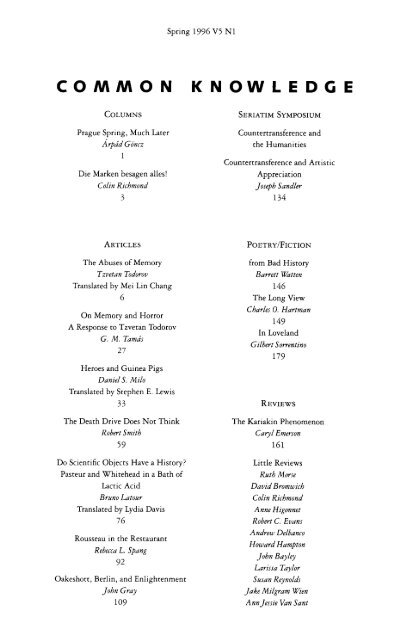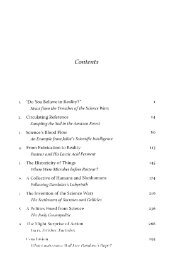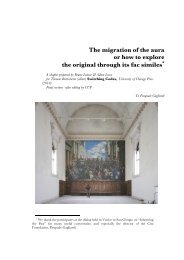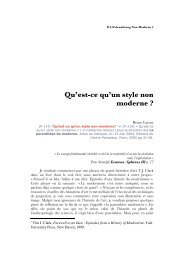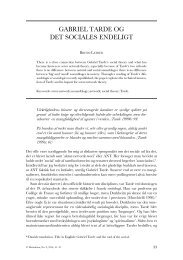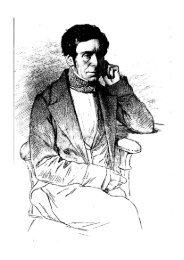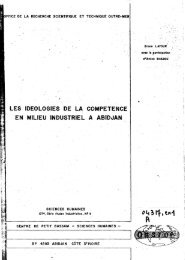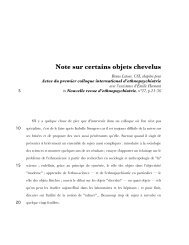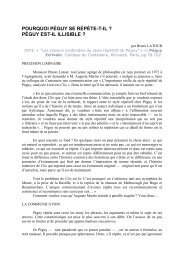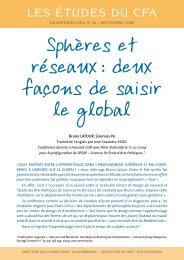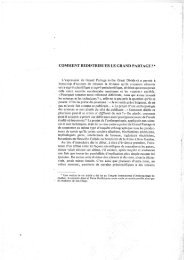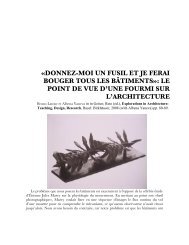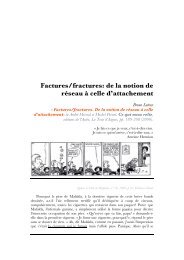Do Scientific Objects Have a History? - Bruno Latour
Do Scientific Objects Have a History? - Bruno Latour
Do Scientific Objects Have a History? - Bruno Latour
Create successful ePaper yourself
Turn your PDF publications into a flip-book with our unique Google optimized e-Paper software.
Spring 1996 V) Nl<br />
COAAfNON KNOWLEDGE<br />
Cor-uuNs<br />
Prague Spring, Much Later<br />
: . , , -..<br />
nrpaa uqncz<br />
I<br />
Die Marken besagen alles!<br />
Colin Richmond<br />
3<br />
ARrrcres<br />
The Abuses of Memory<br />
Tzaetan Todorop<br />
Translated by Mei Lin Chang<br />
6<br />
On Memory and Horror<br />
A Response to Tzvetan Todorov<br />
G. M. Tamâs<br />
27<br />
Heroes and Guinea Pigs<br />
Daniel S. Milo<br />
Translated by Stephen E. Lewis<br />
33<br />
The Death Drive <strong>Do</strong>es Not Think<br />
Robat Snith<br />
,9<br />
<strong>Do</strong> Scientifrc <strong>Objects</strong> <strong>Have</strong> a <strong>History</strong>?<br />
Pasteur and \Thitehead in a Bath of<br />
Lactic Acid<br />
<strong>Bruno</strong> Lataar<br />
Translated by Lydia Davis<br />
-/<br />
/o<br />
Rousseau in the Restaurant<br />
Rebecca L. Spang<br />
9)<br />
Oakeshott, Berlin, and Enlightenment<br />
John Gral<br />
109<br />
SrRrarrv Sylrposruu<br />
Countertransference and<br />
the Humanities<br />
Countertransference and Artistic<br />
Appreciation<br />
Joseph Sandler<br />
r34<br />
Porrny/FrcrroN<br />
from Bad <strong>History</strong><br />
Banett lilatten<br />
r46<br />
The Long View<br />
Cbarles O. Hartman<br />
r49<br />
In Loveland<br />
Gilbert Sonentino<br />
119<br />
Revlrws<br />
The Kariakin Phenomenon<br />
Caryl Emerson<br />
t6r<br />
Little Reviews<br />
Rath Morse<br />
Daaid Bromwich<br />
Colin Richnond<br />
Anne Higonnet<br />
Robert C. Euans<br />
AndrEu Delbanco<br />
Howard Hampton<br />
Jobn Bayley<br />
Larissa Taylor<br />
Susan Reynolds<br />
Jake Milgran tYien<br />
AnnJessie Van Sant
<strong>Do</strong> ScrnNTrFrc Oslncrs Havn a Hrsronv?<br />
PASTEUR AND \qHITEHEAD IN A BATH OF<br />
LÂCTIC ACID<br />
<strong>Bruno</strong> Lafour<br />
Translated by Lydia Davis<br />
But in the rcal world it is more important that a propotition be interesting than it be true.<br />
The importance ol truth is, that it adds t0 interest.<br />
It must be remembered that tbe phrase actual world is /ike yesterday and totnorrma, in tbat it<br />
alters its neaning according t0 standpzint.<br />
-Alfred N. Whitehead, Prccess and Reality<br />
f n ^ ....n, issue o[ Comnon Knowledge,'I followed in some detail the progressive<br />
I<br />
I transformation of a tiny piece of Amazonian forest into scienti6c knowledge. To<br />
do so, I multiplied mediations, replacing the huge vertical gap between words and<br />
world with a horizontal set oftiny translations from one representational medium to<br />
anorher. In that article, the main activity was from the human side, from the scientists<br />
and their instruments, from maps and diagrams and collections. No matrer how many<br />
intermediary steps I unfolded, those steps were still portrayed by me as a way to gain<br />
access to the forest "out there." More exactly, even though the forest "out there" was<br />
reformatted in my paper as a thing circulating "inside" the network of science, this<br />
circulating thing could not be imagined otherwise rhan passiue. The Boa Vista forest,<br />
in itself, was doing nothing.<br />
It is this passivity that I want to try to overcome in this essay. At the risk of taxing<br />
the patience of the readers of Common Knowledge, I will consider another piece of hard<br />
science-borrowed this time, in honor of the cenrenary of his death, from the story of<br />
Pasteur and the history of fermentation. \What has made so many modern philosophers<br />
and theorists shun realism is rhe impoverished role assigned by realist philosophers to<br />
objects ofscientifrc discovery which apparently had no other function, no other onto-<br />
logical life, than to wait silently in the dark before shutting the mouths of the human<br />
agents discussing them. This silent and silencing function was what irritated, and<br />
'"The 'Pédolil' of Boa Vista: A Photo-Philosophical Montage," Common Knruhdge 4 (SPring 1995):<br />
144-t1 / .
DO SCIENTIFIC OBJECTS HAVE A HISTORYI 71<br />
with good reason, those who could not believe in unmediated access to rruth. In rheir<br />
eyes, science is interesting not because it offers unmediated access ro tl-re world, but<br />
rather another form of mediation, of transcendence, of truth warmly clothed.<br />
The question I wanc to ask is whether it is possible to develop a sort o[realism rhat<br />
would offer the agents of the world a more inceresting role than that of passive objecr.<br />
Strangely, not many philosophers are interested in this metaphysical quesrion. No<br />
matter whether they worship or hate science, most rhinkers take for granted that scien-<br />
tilic objects, accessible or not, behave as realisrs believe them to [shavs-1h21 i5, In a<br />
passive and indifferent manner, wholly impervious to human history. The only alrerna-<br />
tives that most philosophers can imagine are animism and arnthropomorphism, horrors<br />
to which they always prefer the canonical version of objects seen sub specie scientiae.<br />
A. N. Whitehead is one of the interestingl exceptions, and it is his "historical realism,"<br />
though largely out of fashion, that I want to use as my guide or goad for this explora-<br />
cion. But since I am only half a philosopher, I need an empirical site in order not ro<br />
lose myself in questions that quickly become too deep for me: my project, then, will<br />
be to imagine how \Whitehead would have accounred for Pasteur's understanding o[<br />
the discovery of lactic-acid fermentation in 1858.<br />
Sollr REcpNT CoNTRovERsTES rN ScTENCE Sruorrs<br />
The sintple nltilil 0f an endaring sultstance sastaining persistent qtalities. either essen-<br />
tia/ly or accidenta/ly, expresses a asefa/ abstract for many pn'poses af /{e. Bnt ubetteuer<br />
u,e try t0 urc it at a fundamental statentent af tl.te nature of things, it prorcs itself mistaken.<br />
It arose fron a nistake and has nn,er sucreeded in any af its applications.2<br />
This critique of substantialism. so important for Whitehead, could be shared by nu-<br />
merous historians and sociologists of science, but ior very different reasons. In an ac-<br />
count ofa discovery, one should nat, ^ccording to students ofscience, refer ro a sub-<br />
stance external to the human work involved in order to explain its genesis.r Of course,<br />
like Kant, most contemporary historians, in order to avoid the extremes of idealism,<br />
do not deny the existence ofsuch a subsrance, but rhey wish to emphasize the concrete<br />
attributes only of the mind that knows or, in more recent hisroriography, only o[ che<br />
practice of the scientific group rhat man.iiulares and demonsrraces che subscance<br />
within the closed and local precinct ol the laboratory.l According; ro them, in order to<br />
fo<br />
'Alfred N. Whitehead, Procer anl Rea/it1:.\u Essal tnCosrtulogl lNew York: Free Press, lIc)29) l9l8),<br />
rThe canonical description of this principle qan be t-ound in Harry M. Collins.ChangingOrdu: Repl)catiat<br />
and Induction in Scientif;c Practice (London: Sage, l!85).<br />
'The<br />
most developed examples can be firund in Steven Shapin and Simon Schaffer, LtLiatban and the Air,<br />
PmQ: Hobbes, Bayte and tbe Experinental Ly'i (Princeton: Princeton University Press, 1985), and, more re-<br />
cenrly, Christian Licoppe, Zz Forrtttnn J, /,t ptttiqrc rLrtrrQqre (Paris: La Découverre, 1 996).
18 COMMON KNO\flLEDGE<br />
criticise substantialism, one must quite simply abstain from giaing a role to nonhamans in<br />
the story ofa discovery and instead consrrucr the account exclusively with reference to<br />
rhe praccices, the places, rhe insrrumenrs, rhe auchorities, rhe insr.irurions, and rhe<br />
historical events furnished by the conrext. Such historians hope that a multitude of<br />
small determinations when added to one anorher will count for as much as rhe always-<br />
already-there substance of the old-fashioned accounts o[ discoveries. However, as Isa-<br />
belle Stengers has clearly shown in a recenr book,5 there is something unlikely for rhe<br />
practicing scientist in this approach, something unrealistic, nor only in the philosophi-<br />
cal sense of the word but also in the common meaning of improbable. Someching<br />
essential seems missing from the account. Is it precisely essence that is lacking? No,<br />
and it is $/hitehead's interest to imagine a realism without substance, a raàical hisrori-<br />
cai realism ("The Castle Rock of Edinburgh exists from momenr co momenc, and from<br />
century to century, by reason ofthe decision effected by its own historic route ofante-<br />
cedent occasions.")6<br />
It has seemed necessary to some of us to devise what we call in our jargon "prin-<br />
ciples of symmetry" in order to do justice-without falling back on essenrialism-ro<br />
the feeling scientists and common sense share that somerhing is missing from accounrs<br />
of science that consider only the human side. The first principie of symmetry de-<br />
manded that historians judge accounrs of discovery fairly by rrearing on terms of<br />
equality scientists who have been wrong and those who have been right.' This prin-<br />
ciple, which is opposed ro rhe French episremological tradition rhat demands one dis-<br />
tinguish "out-of date science" from "sanctioned science,"8 permitred nice effects of<br />
historical drama. The victories of Boyle over Hobbes, of Newton over Descarres, or of<br />
Pasteur over Pouchet, no longer differed from rhe provisional victories of Napoleon<br />
over Tsar Alexander, or ofClinton over Bush. The history ofscience ceased to be distin-<br />
guished from history plain and simple.<br />
The price paid for this reuni6cation was very high. The principle of iimired symme-<br />
try does not equalize the possibilities of the victors (rationaliry) and the vanquished<br />
(irrationality) except in that the principle forbids borh protagonists access ro rhe very<br />
phenomena that they both consider their only reason for being. There is something<br />
heroic in this: nature, the symmetrical historians all say with a yogi's ascericism, does<br />
noc intervene in the interpreracions we make with respect to it.<br />
tlsabelle<br />
Stengers, L'lu'ention dzs scieues modunes (Paris: La Découverte, 1993).<br />
6\Thitehead. 41.<br />
'See<br />
David Bloor, Krcu'ledge and Soiial lnagery lChicago: Universiry ofChicago Press, [1976] l99l). For<br />
a more recent justi6cation, see rhe preface to rhe second edition<br />
sSee<br />
Georges Can guilhem,ldeolag'and Rationalitl, in tbe <strong>History</strong> of tbe Life Sciene:, trans. Arthur Goldhammer<br />
(Cambridge: MIT Press, I19681 1988), tbr an exrreme example. See also, more recenrly, G. Canghuilhem,<br />
A Vital Rationalist: Selected Vrittngs. rraos. A. Goldhammer, ed. François Delaporre (New York: Zone<br />
Books,1994).
DO SCIENTIFIC OBJECTS HAVE A HISTORY? 19<br />
one can understand the motives of historians who are pâfrisans of symmetry-they<br />
are reacting againsr the abuses ofsubstantialists who are content to exPlain that vlctors<br />
in the history of science won because they were more rational or had better access to<br />
rhe nature of things. By insisting, for the first time, on the difficulties of the experi-<br />
menr, on the uncerrainties of the instruments, on the irremediable localization of the<br />
merhods, on rhe ambiguity of interpretations, on the importance of a community of<br />
more or less credible colleagues, the constructivist historians find it easy to ridicule<br />
those who believe they benefit from immediate access to the real and who take social<br />
of cognitive habits that date only from yesterday to be the permanent essence ofthings.<br />
It is imporrant, however, to avoid pressing ascericism ro rhe poinr ofanorexia, and<br />
this is where another, more general, principle of symmetry becomes necessary.e No<br />
longer is it a matter of equalizing the possibilities for success of the victors and the<br />
vanquished by evenhandedly forbidding both groups access to the real but rather of<br />
equalizing by allowing all groups to construct simultaneously and symmetrically both<br />
their natural reality and their social reality. Like yogis who have been without food too<br />
long and forced to sleep too many nights on beds of nails, one Ênally allows victors<br />
and vanquished alike to gorge themselves on reality and sleeP in featherbeds. This<br />
shift enables recovery from Kantianism since one no longer has to choose, in order to<br />
explain a discovery, between privileged access to the real and determination through<br />
thousands ofsmall social or practical causes. One sees in effect that the real as a reserve<br />
or anchor against idealism had meaning only by contrast with the knowing mind (or<br />
the laboratory, or the paradigm). For every Copernican revolution, there is a countef-<br />
revolution and a half. Discoverers establish at once what they afe, the world in which<br />
rhey are situated, and the numerous social, practical, and historical causaiities comPat-<br />
ible with rhe type of phenomena with which they are populating the collective. The<br />
differences among ontological, epistemological, and sociologicai questions become in-<br />
distinct. The question becomes: In which socionatural world do we agfee to live? The<br />
principle of generalized symmerfy does not abolish the principle of limited symmerfy,<br />
bur extends it to questions about nature and about society, and thus allows a new<br />
object to appear-the co/lectiae of humans and nonhumans.r0<br />
This solution, however, does not have the meraphysics of its ambirions. while no<br />
longer anthropomorphic, it remains as fragile as the meaning given to the wotd collec-<br />
tiae. If one means by that word the demiurgic activity of researchers in engendering<br />
not only nacure but also society and the history in which they are situated, one comes<br />
dangerously close to the tales of the absolute idealists that believed they couid go<br />
,,beyond Kanr." \Thereas if ir is semioric proliferation thar endows humans, nonhu-<br />
eSee <strong>Bruno</strong> <strong>Latour</strong>.rYe Hat,e Neter Beer Ilodern, trans. Catherine Porter (Cambridge: Harvard University<br />
Press, 1991), for a presentation of this principlc and its consequences for anthropology.<br />
'oSee B. Larour. "On Technical N{ediation,' Courron Knouledge 1 $aII 1994):29-61.
80 COMMON KNOITLEDGE<br />
mans (i.e., objects in circulation), enunciative positions, and the contexts inscribed in<br />
texts with certain properties, then we are awash in discourse, in a sea of positions<br />
without subjects, and we drift farther from the realism that we were aiming for. The<br />
"superman" of the 6rst (the demiurgic) account is abruptly followed by the "death of<br />
man" in the second. In a third account the activity of researchers is a matter of allowing<br />
nonhumans to proliferate in society as subjects, in which case we run the risk o[ natu-<br />
raliztng the whole of history without any longer being able to endow obiects with<br />
their uncertainty, their transcendence, their "tremolo." This third account relies on a<br />
will to power to anchor discourse and action in biology or in physics.<br />
In order to be sure of escaping these three perils-being trapped in society. in<br />
language, 61 In n4gu1g-we must leave behind for a momenc the ambiguity of the<br />
word co//ectitte and abandon the notions of actors, actions, subjects, objects, humans,<br />
and nonhumans that have provisionally served to enabie our escape from Kantianism.<br />
Thus we must dare, Iike rùThitehead,<br />
to have commerce with metaphysics despite the<br />
embargo declared against it by analytic philosophy as well as by constructivism.<br />
How PasrruR STAGES HIS o\rN DtscoveRv or<br />
THE LACTIC ACTO FENUEN-r<br />
In 18)8, sometime after having discovered the fermentation of brewer's yeast, Pasceur<br />
relates, in a celebrated report to the Académie des sciences, the discovery of a yeast<br />
peculiar to lactic acid.lt Today, Iactic fermentation is no longer an obiect ofdiscussion,<br />
and one can order by mail any quantities of yeast for dairies, creameries, and cheese<br />
manufacturers the world over. But one has only to "place oneself in the conditions of<br />
the period" to measure the originality of Pasteur's report, and chus the reward he can<br />
claim for his pains. In the middle ofthe nineteenth century, in scientiÊc circles influ-<br />
enced by Liebig's chemistry, the claim that a speciÊc microorganism could explain<br />
fermentation amounted ro a srep backward, since it was through ridding itself of ob-<br />
scure vitalist explanations that chemistry had only just won its laurels.r2 Fermentatton<br />
could and had been explained, without the intervention of any living thing what-<br />
soever, in a purely chemical way by the degradation of inert substances. In any case,<br />
specialists in lactic fermentation had never seen microorganisms inseparably associated<br />
with the rransformation of susar:<br />
ttThe English rext is "Pasteur's Study of Fermenrarion" in HaruatdCaseHistuies it Exprimental Science.<br />
vol. 2, ed. James B. Conant (Cambridge: Harvard University Press, 1957), 453-60. A fuller semiotic analysis<br />
of Pæteur's repon can be found in my "Pasteur on Lactic Acid Yeast: A Partial Semiotic Analysis,"<br />
Confgurations 1 (January 199)): \27-42. For a general presentation ofPasteur's career, the besr source rs<br />
now Gerald Geison,Tbe Priuate Science of Louis Pasteur (Prrnceron: Princeton University Press, 1991). In this<br />
article, I am concentrating on the text in order to extract from it its various ontologies, and not concerning<br />
myself with other material (æ I did fbr the Boa Vista tbrest; Conman Knou'ledge 4:1,1{4-87) that would<br />
connect me more securely to Pasreur's Iaboratory and method.<br />
"For a descriprion of the chemists and their professional ideologies at the time, see Bernadette<br />
Bensaude-Vincent and L Stengers, Hi:toire de la chiilie (Paris: La Découverte, 1 991).
DO SCIENTIFIC OBJECTS HAVE A HISTORY2 81<br />
lJntil nou minate ruearcbes baue beenunable to discover the dnelopment of organized<br />
life. Obsen,ers u,ho hate idcntifud some organisms haue at tbe sane time fotmd that rhry<br />
u,ere acciàental and detrimental to ilse process.<br />
Tbe faas Tl:en seem very favorable to the ideas of Liebig or to tbote of Berzelias. In the<br />
eya of the former d ferment is an anstable substance that decomposes and therebl excites<br />
fennentation in consequence of its a/teration u'bich commmicdrer d disinte&rating distar-<br />
l)ance t0 the nolecular grotp of the fernentable matter According to Liebig, silch is the<br />
primary cause of all fernentations and the origin of nost contagious diseases. Bazelias<br />
be/ia,es that the cbenical act offermentation is to be referted to the action ofcontact. These<br />
lpinilns gain more credit daily. . . . These worhs all agree in rejecting the idea of<br />
some sorr of influence frcm organization and life as a caase 0f the phenlnena that<br />
ue are considerizg. (Emphasis added.)<br />
And Pasteur quietly adds: "I have been led to an enrirely different point ofview"!1r<br />
The discoverer will appear all the more involved in the process because he will have<br />
everyone againsr him, the unanimous opinion of the chemists as well as rhe scrupulous<br />
research ofthe specialists. The discoverer does not lift rhe veil behind which the yeast<br />
in lacric fermenration has always been hiding. Like the srory of General de Gaulle<br />
rising from obscurity to triumph, the discoverer's srory can be rold as a tale of victory.<br />
But Pasteur's acr was not rhe imposition o[a framework or vision on powerless mat-<br />
ter-though he later posed the problem to himself in these terms (as we shall see). He<br />
states, in fact, rhat he has been led to a poinr of view. His activity consists in allowing<br />
himself to be carried along by the "propensity of things," to adopr François Jullien's<br />
beautiful expression.Ia Even when Pasteur acts to cause the yeast to emerge, in opposi-<br />
tion to the convictions of the rest of the world, he srill allows himself to be led by<br />
things-thus mingling once again the fate of a subject and an object.<br />
For politicai and military history resources exist that allow one to weigh the respec-<br />
tive roles of longae durée, opportrtnrry, circumstances, chance, individual genius, and<br />
Ênally the arrribution of responsibility to a few individual geniuses. However, when it<br />
is a matter ofaccounting for beings who have been invented or discovered, the histo-<br />
rian of science becomes more rimid, more hesiranr than his colleagues. The hisrorian<br />
of science accosrs one monscer more than che hiscorian plain and simple: however greac<br />
may be the heterogony of factors that history summons, it is never as grear as in the<br />
history ofscience, where one must inregrare rhe short life ofPasreur, the longer span<br />
of the Second Empire or of chem.istry, the even longer existence of alcoholic or lactic<br />
fermentations (which go back ro Neolithic times), and rhe existence, infrnitely longer,<br />
'J. B. Conant, 455.<br />
'aSurprising resonances exist between \Thitehead, op. cit., and. this admirable book on Chinese philoso-<br />
phy: François Jullien, Tbe Propensity oJ'Tbings: Tou'ard a H istory of Effvary in China (New York: Zone Books,<br />
r99t).
82 COMMON KNO'i/LEDGE<br />
absolutely longer, of lactic acid yeast, always already presenr. Once discnered by Pasteur<br />
in 1857,lactic acid yeast has always already been there, from Neolirhic times in the<br />
gourds of homo sapiens to the presenr in che whey rhat is souring in all rhe dairies on<br />
earth. How should one go about historicizing the creation of a being that seems to<br />
overflow its historical framework immediately, to go back through rhe whole of time<br />
and spread through the whole of spaceT Historians are used to dealing wichche /angae<br />
durée, l:ut how to deal with timelessness?<br />
The only solution consists in bestowing historicity on all elements that enrer inro<br />
an account. Young Louis Pasteur of Lille counrs as an episode in the destiny, in the<br />
essence, in the trajectory of lactic yeast: The absurdity ofa premise like this, the scan-<br />
dal it may provoke, is broughr home if, instead of to yeast, srill close to rhe agirated<br />
history of living things, rhe premise is applied co gravitation or cosmoiogy. Newton<br />
happened ro universal gravitarion? The European Cenrer for Nuclear Research hap-<br />
pened to the Big Bang?<br />
If, once again seeking refuge in rhe cozy Kantian framework, one were to speak<br />
only of represewarion, there would be no difficulry here. Pasteur would be said to trans-<br />
form the ideas that chemists and dairymen have formed "about" lactic fermenrarion,<br />
much as Newton modified our ideas about the action of disrant celestial bodies. One<br />
would return more easily ro history if one remained exclusively among humans wirh<br />
their representations, their visions ofthe world, their more or less passionate interests.<br />
The history ofscience, social or intellectual, could be deployed, like most ofanthropoi-<br />
ogy, with a boldness all the greater because it would be limited ro representarrons<br />
alone, leaving the phenomena rhemselves out of reach. But, given generalized symme-<br />
try we want to reach rhe phenomena, ro emerge from the childhood home of ideaiism<br />
and rediscover, with realism, the risks of ontology wirhout losing the uncertainties of<br />
history or the localizarion of methods.tt \7e musr rherefore explore this path, however<br />
bizarre it may appear, and speak of Pasreur as an euent that occars to lactic acid.<br />
Snvrnal ONror-ocrss \?rrH VaRtngLr Gsol{stRrrs<br />
What seemed absurd in a metaphysics of essence and attributes can become child's<br />
play for "an ontology of evenrs and relacions."t6 In \Whitehead's vocabulary, Pasteur's<br />
laboratory appears to us an occasion offered to trdjectlries ofentities that inberit preceàing<br />
"S7hat is involved, in fàct, is atrributing to rhe following passage in Kuhn an ontology, where, in his<br />
understanding o[ it, it hæ a psychosocial meaning: "[T]hough rhe world does not change with a change of<br />
paradigm," he writes, "tbe scientist aftmtard umhs in a diffrent uorld, Nevertheless, I am convinced that we<br />
must Iearn to make sense of statements that at least resemble these. \ùfhat occurs during a scientifrc revolution<br />
is not fully reducible to a reinrerpretation of individual and srable dara." Thomas S. Kuhn, Tbe Strrctare<br />
ofScient$cRaolations(Chiczgo: UniversityofChicagoPress, t1962]1970),121.<br />
L6I am borrowing these terms from the excellent article byJohn B. Cobb, "Alfred North !7hitehead,"<br />
in Famdtrs of Con$ructiue Plrtîtzdern Philuopby, ed. David Ray Grif6n (Albany: State University of New York<br />
Press,1993).
DO SCIENTIFIC OBJECTS HAVE Â HISTORY2 83<br />
circumstances by deciding to persevere in a new w^y of being. Certain entiries will<br />
travel through the laboratory as stabilized practices. This is the case oflactic acid itself:<br />
LacticacidwasdiscoueredbyScbeelein 1780 insotredu,bey. Hriprocedure forremouing<br />
it from the u'bey is still today tbe best one can follou.<br />
In a footnote, Pasteur adds:<br />
First he reduced the whey to an eigbth of its uolume by euaporation. He frkered it and<br />
sarurared it uith line t0 precipirare tbe phoQhate of line. The liqaid was then filtered<br />
and àiluted u,ith three times its weight of uater; into tbit be potred oxalic acid drop by<br />
drop to precipitare all the lime. He evaporated the Iiquid to the consistency ofhoney. . . .<br />
(Emphasis added.)<br />
Even here, the acid is not presented as a substance durable in time and defined by<br />
its attributes but rather by a collection ofverbs referring to laboratory gestures. Acid<br />
is ultimately aprocedure, a recipe, and is coextensive with a course of acrion. The fact<br />
that the list of operations is long hardly matters, since each of rhem is parr of rhe<br />
routine of a well-equipped chemistry laboratory. The interlocking of che subprograms<br />
does not make the essence fragile because skillful chemists have no trouble understand-<br />
ing the gestures for frltering, evaporating, precipitating, and because they take their<br />
arrangement as monoiithrc.<br />
The same is not crue for the yeast thar the entire scientific communiry found so<br />
dubious in 1817:<br />
If one examines carefully an ordinary lactic fumentation, there are cases wltere one can<br />
Ênd on top of the dcposit of the cbalk and nitrogenoas nataial spo:s 0f d gray substance<br />
uhich sometines form a layer on the sarface of the deposit. At othu tines, this sabttance is<br />
fomd<br />
adhering t0 the t/p\er sides of the uesre/, uhere it has been canied fu effewescence.<br />
Undu the microscope, wben one is notforeuarned, it is hardly possible to distinguish it<br />
from casein, disaggregated ghten, etc,; in sltort, nothing indicates tbat it is d sepa.rdte<br />
material or that it originated during thefumentation, lts apparent weight aluays rentains<br />
very little dr clmpared to that of the nitrogenoas nnterial originally necessary for the<br />
carrying out of the pracess. F inally, very often it r so mixed witb tbe mass of cdrein and<br />
chalhtbattbaewou/dbenorearznt0suspect itsexiitence. ltisnnerthelessthissubstance<br />
that plays the principal role. (Emphasis added.)<br />
The very existence ofthe yeast is in question, as rhar oflactic acid is not. There are<br />
no routinized gestures that would allow one to assure the regular presence of yeast.<br />
The entity is defrned only by a "degree zero" ofexistence, appearing as "spots o( a gray<br />
substance which sometimes form a layer on the surface of the deposit." One could<br />
scarcely exist less! The contrast appears all the stronger in the act of defiance with<br />
which the quotation above concludes. In opposition to Liebig and Berzelius, as we<br />
have seen, Pasteur was "led to an entirely different point of view." This thought process
84 COMMON KNOVLEDGE<br />
depends on a conversion by which a creature of whom one does not have "reason to<br />
suspect its existence" "nevertheless<br />
plays the principal role"!<br />
In order to follow how the yeast-criticized by everyone, invisible, a poor spot at<br />
the bottom of a glass vessel-will soon become the "only thing responsible" for lactic<br />
fermentation, the expressions "subject" and "object" must become, as one may imag-<br />
ine, of litcle use. Pasteur plays his large part in this affair, as do the yeast, Liebig, and<br />
the dairymen. \7e do not observe a man endowed with faculties discovering a creature<br />
defined by attributes. \7e see a body with multiple and partial members seeking to<br />
bring about in its laboratory, through a series oftrials, a regular succession ofactions:<br />
I am going to shou, f.rst of all, hc,u, to isalate it and prepare it in a pare state.<br />
I extract the solable part fron breu'er\ yeast, bl trea.ting the yeast for some time wirb<br />
fifteen to tu)entJ timer its weight 0f uater at the temperatare of boiling uater. The /iquid,<br />
a clmplex szlution of albuminous and mineral material. is carefully filtered. Altout ffty<br />
to one handred granx ofsugar are then dissolaed in each liter, some chalk is added, and a<br />
trace of the gray materia/ I haue just mentilned extracted frlm a good, ordinary lactic<br />
fermentation ri sprinkled in; then one raises the temperatare to 30 or 35 degræs Centi-<br />
grade. It is also good to introduce a carrent of carbonic acid )n order to expel the air<br />
fron the flask, which is Jitted u,ith a bent exit tube immersed ander u,ater. On the aery next<br />
day a liaely and regularfermentatizn is manifest. (Emphasis added.)<br />
In the laboratory, the body ofPasteur, careful and skilled, serves as the occasion, the<br />
circumstance, the concrescence of the enduring establishment of lactic fermentatron.<br />
Through gestures (filtering, dissolving, adding), ingredients (brewer's yeast, solution,<br />
chalk), hxtures (faucets, receptacles, ovens, tubes), instruments for measuring (ther-<br />
mometers, scales, thermostars), and little tricks of the profession, fermentation be-<br />
comes visible and stable. At this stage of variation, the essenc€ of fermentation rs coex-<br />
tensive with the deployment of practical and locai circumstances.<br />
Granting historicity to the yeast, in this instance, goes much further than a simple<br />
return to the contingencies of the period in question. It is no longer a matter simply<br />
of going back to Pasteur, trembling in his laborarory with fear that he might lose his<br />
fermentation and that his yeast might not be a "correlative to life." The lactic fermenta-<br />
tion is also trembling. This controlled manifestation, "lively and regular," has never<br />
happened before, since the world began, to yeast, anywhere. The small iaboratory of<br />
the dean of the faculty of science at Lilie also constitutes a decisive juncture in the<br />
trajectory of this fermentation since here it becomes visible and pure. It is no longer<br />
only Pasteur who alters his "representation" of the fermentation, but the fermenrarion<br />
itself(in its being, in its history, in its ascents and descents) that modifies irs manifesta-<br />
tions.<br />
If Pasteur hesitates, the fermencation is also hesitating. Ambivalence, ambiguity,<br />
uncertainty, and plasticity bother humans groping their way toward phenomena that
DO SCIENTIFIC OBJECTS HAVE A HISTORY/ 8'<br />
are in themselves secure.li But ambivalence (etc.) also accompanies creacures to which<br />
the laboratory offers the possibility ofexistence, a historic opportunity. Fermenrarion<br />
has experienced other lives before now (1817) and eisewhere, but its new concrescence<br />
is a unique, dated, localized life made up in part sf p256sru-himself transformed by<br />
his second great discovery-and in part of the laboratory. By speaking of events de-<br />
fined in terms of their relations, I am sketching here the history of Pasteur and his<br />
yeast, ofthe yeast and l/s Pasteur.<br />
FRolr rsn EveNr ro rHE SussraNcs<br />
By describing in this way the shared history ofa researcher, a discipline, a laboratory,<br />
a lixture, a yeast, and a theory, one does not for all that lose the substance and its<br />
attribuces, but the meaning of the word substance changes profoundly and becomes the<br />
gradual attribution ofstable properties attached by an instirution to a name lastingly<br />
linked to a practice, the whole circulating in a relatively standardized network. This<br />
transition from the event to the newly defrned substance poses a formidable problem<br />
of description and interpretation from which Pasteur extricates himself through two<br />
apparent contradictions.<br />
At the beginning of his report, the author does not yet know which properties to<br />
attribute to which essences. By the end, the yeast possesses the same solidity as rhar of<br />
brewer's yeastr recently discovered. The substance endowed with attributes offers a<br />
parricular case of the event deÊned by its relations, a manner of summarizing, of rou-<br />
tinizing, of stabilizing, of institutionalizing events. It is as though one began with<br />
attributes before coming to an essence. Let us take this transition, rarely studied, be-<br />
cween two completely different ontological states summed up in two paragraphs of<br />
Pasteur's report:<br />
Ler us consider nlu ahat are the characteristics of this stbstance, rhe prldactizn 0f<br />
u,bich goes band in band u,ith tbose phenomena that, taken T0getber, we call lacticfernren-<br />
tation. Yiewed as a mass lr looks exactl like ordinary pressed ttr drained yeast. lt is<br />
sligbtly uiscous, and gray in color Under the microscope, it appears to be formeà af<br />
litt/e globul,es oruery sbort segmentedfi/aments, isolated or in clusters, u,hichform irregu-<br />
lar faku<br />
resembling those of certain antorpboas precipitates. lt can be co\Iected and<br />
transported for great distances withoat losing lrs actiuity, u,hich is weakened only<br />
tahen the material ls dried or u,hen lr ls boiled in u,ater. Very lictle of tbis yast is<br />
nece:sdry /a transform a nnsiderable weight of sagar. . . .<br />
t-It<br />
is the mistake ofsocial constructivists to accord inwpretiufexibilil_y only ro researchers acrively<br />
engaged with the data. To introduce nonhumans would always amount, according to him, to silencing<br />
controversies. Inversely, Hacking has no difliculty giving a constructivist reading of social facts since it is<br />
understood, once and for all, that they can correspond to norhing but arbitrary, self-realizing prophecies.<br />
Ian Hacking, "Vorld-Making by Kind-Making: Child Abuse for Example," in Hau. ClassiJiation tYorks:<br />
Nelson Goodntan Amang the Sodal Sùencr, ed. Nelson Goodman, Mary <strong>Do</strong>uglæ, and David L. Hull (Edin-<br />
burgh: Edinburgh University Press, 1992), 180-231.
86 COMMON KNOWLEDGE<br />
,'Hae ue fnd<br />
all the general characteristics of breuer's \east, and these substances<br />
probablT hate organic sftuctales that, in a nataral classiÊcation, place then in neigh-<br />
boring species or in tut connected hmilies " (Emphasis added')<br />
In rhe frrst patagraph, rhe essence is defrned only by various trials to which one<br />
submits the anonymous "special substance," recording resPonses that have fecently<br />
become stable thanks ro rhe care and skill ofthe scienrist and to the laboratory's genius<br />
loci. Each trial brings a new surprise: "x" can be transported without weakening! so<br />
litrle "x" is needed to transform so much sugar! Still, attributes float without being<br />
able to attach themselves ro a substratum. one senses in the text Pasteur's hesitarions,<br />
scruples, shilly-shallying before a viscous, Sray matter that resists dryness and boiling'<br />
The trial defines it in all its freshness, as though, to use the vocabulary of semiotics,<br />
one could induce competences only on the bâsis of troublingperformances.<br />
But in the nexr paragfaph, the coalescence has taken place. The "special substance"<br />
no longer merely fesembles brewer's yeast, it is no longer merely composed of globules,<br />
ofirregular flakes. The yeasr, now named, becomes a substance and occupies a clearly<br />
locatable position in a classification by family and by species. The attributes that<br />
floated randomly become rhe marks of an enduring essence-not simply of a stabilized<br />
routine like the iactic acid with which we began'<br />
How can we explain the transition from a long series of hesitant trials to a being<br />
summed up in a name? The answer of those historians o[science who are inspired by<br />
the firsc principle of symmetry leaves no doubt..\Tithout PresuPPosrn8 an organtsm'<br />
Pasteur never could have reduced up the long list of trials into a single yeasc' Ac-<br />
cording to hisrorians of science since Duhem, one has in fact always needed a theory a<br />
prejudice, a PresuPposition' a concepcual framework, a paradigm' in order to organize<br />
data that one can never encounter face to face: the inevitable return to Kant and his<br />
sociologisr followers. curiously, Pasteur asks himself the same question and seems to<br />
espouse the constructivist thesis before contradicting himselfa second time:<br />
All throagh this menoir, I haue teæoted on the basis of the hypothuis that the rygu yedrt<br />
is organized, that it is a liuing organism, and That its chemical action on sagar corresponds<br />
to itt deuelopment and organization. If someone weft t0 tell ne that in these conclasions I<br />
am going beyond that which the facts prot,e, I uould answa that this is quite ffae' in the<br />
sense that the scand I am taking is in a framework of ideas that in rigorots terms<br />
cannot be in{utab\ demonstrated. Hae is the way I see it; u'bern'er a chemist makes<br />
a stady of these nysterioas pbenomena and has tl:e goodfortune to bring aboat an intp|rtant<br />
deuelopment, he uill instinctively be inclined t0 asriSn its primary cal'/re t0 a t\pe of<br />
reaction consistent sttth the genaal resalts of his oun reseatclt. It is the logical course of<br />
tbe human ntind in all controtasial questions' (Emphasis added )<br />
In rhe purest (French) rarionalisr tradition, Pasteur insrsts on the necessity of a<br />
theory in order to make facts speak and, in the same breath, brings rnto play practical
DO SCIENTIFIC OBTECTS HAVE A HISTORYT 87<br />
training in chemistry, instinctive inclinations, the "logical course" of the human mind,<br />
and personal perspective. He knows that one must follow reason to find the facts. But,<br />
in spite of the superÊcial resemblance to social constructivists, there is nothing in<br />
Pasteur's rhetoric to enchant them because, without fear of contradicting himself,<br />
Pasteur goes on to the most traditional realism, and tranquilly afÊrms:<br />
And it is ny opinion, at this point in tlse deuelopnent of my knowledge of the sabject, tbat<br />
whoever jadges impartially the resalx of this u,ork and that which I shall shortly pab-<br />
lish wrI\ recognize with me that fermentatizn appears to lte correlatiue to life and to<br />
the organization of globulu, and noT to their death or putrefaction. Any contention that<br />
fetmentation is a phenomenon due to contact in which the transformation of vgar takes<br />
place in the presence of tbe ferment without giuing up arything to it or taking dryTbing<br />
from it, is contradicted by experiment as will be soon seen. (Emphasis added.)<br />
Give me impartial colleagues, he says, and they will recognize what the experiment<br />
incontestably affirms-the same experiment that had required after-the-fact presup-<br />
positions without which the presence of microorganisms couid not be demonstrared.<br />
Pasteur ignores this flagrant contradiction and moves from a realist to a construcrionisc<br />
epistemology in much the way that the yeast smoothly moves from event to substance.<br />
Before reading Whitehead, I could not extricate myself from this dilemma. It<br />
seemed that we always had to choose between two evils: S7hitehead opens a new possi-<br />
biliry and allows us to understand why the contradiction is only apparent. Lactic-acid<br />
yeast changes its history upon contact wich Pasteur and his laboratory. It is quite real,<br />
but its historical reality puts it on an equal footing with the researcher and the labora-<br />
tory in which it is involved. Lactic acid has also changed. The yeast has taken the little<br />
push that Pasteur has given it as a historic opportunity to manifest itself by altering<br />
its entire trajectory. The yeast proposes, Pasteur disposes. Pasteur proposes, the yeast<br />
disposes. Pasteur has not imposed his views on an infinitely plastic form, nor tenta-<br />
tively discovered the resistance of an infrnitely robust form; he has given a phenome-<br />
non its chance. This is why, writing his report, he sees no contradiction between his<br />
realist and constructivist rhetoric, though everything discinguishes them in the eyes<br />
of an epistemologist or a social historian. An ontology, even more counterintuitive<br />
than that of the sociai historv of science. allows us to foilow the common sense of<br />
a scientist:<br />
The experinenter, a man of conquest ûuer natilre, finds bimself cease/ess/y at grips uitb<br />
facts that are nlt let manifested and exist, for the most part, only potentially in<br />
natural Iaw. The unknown in the bossible and not in wbat has been-this is his donain,<br />
(Emphasis<br />
added.)'8<br />
r3louis<br />
Pasteur, Oeares complètes,7 vols. (Paris: Mæson, 1939), 7:)34.-Trans. L. Dauit
88 COMMON KNOlYLEDGE<br />
Tbsrso sy lùfHrrrFreRo<br />
Vhy does positing the historicity of all things, even though this solution may in che<br />
end be reconciled with common sense, appear at lirsc sight so unlikely, so senseless2<br />
Because ofour ideas about nature, about transcendence, and about causality, ideas that<br />
l7hitehead allows, profoundly, to dismiss.<br />
Suppose we were to calculate the ingred.ients rhat enter into rhe composition of<br />
Iactic yeast of I8)7 in order to understand the coproducrion of this scientific fact.<br />
Once the accounts ofdiscovery in the old mode have been abandoned, along with the<br />
more recent accounts ofsocial construction, we musr draw up a heterogeneous list thar<br />
includes, among many other factors, Pasteur, the Faculty of Science at Lille, Liebig,<br />
cheesemongers, laboratory appararus, brewer's yeasr, sugar, and lactic yeasr. There is<br />
no essentialism in this list since each entity is defined only by its relations. If the<br />
relations change, the definition changes similarly; rhe Faculty of Science with and<br />
without Pasceur is not exactly the same Faculty; sugar with and without lactic yeast is<br />
not quite the same sugar; lactic yeast after and before 18)7 is not ar all the same yeasc.<br />
But history cannot be defined by a simple rearrangement of factors. <strong>History</strong> is not<br />
created from already made ingredienrs. To avoid rhe jangling of combinations, rhe<br />
atomism of factors, we must thus recognize in every compound, in every concrescence,<br />
something more, some rad.ical and unique capacity for innovation-and, to do so, we<br />
must accept the fact that events, to deserve their name, are in part without cause.<br />
As absurd as that appears, realism demands that one abandon rhe idea of causality as<br />
compulsory movement or as a displacement of forms. The discovery of lactic yeast.in<br />
1857 is not due to a dispersal of infinitesimai conditions that defr calculation but of<br />
which each, nevertheless, acts as a cause. For there to be history, the yeast-of-1817-at-<br />
Lille-with-Pasteur must in part be caasa sui,te<br />
Nowhere in the universe does one find a cause, a compulsory movement, that per-<br />
mics one to surn up any event in order to explain irs emergence rerrospectively. If it<br />
were otherwise, one would not be faced with an event, with a difference, but only wirh<br />
the simple activation of a potential, the mere actualization of a cause.'u Time would /a<br />
nothing and history would be in vain. The discovery-invention-construction of lactic<br />
yeast requires that it be given the status ofa mediation, that is, ofan occurrence that<br />
is neither altogether a cause nor aitogether a consequence, nor completely a means nor<br />
completely an end.<br />
Pasteur can be understood as an event occurring to lactic yeasr because he is unfore-<br />
'e"All actual entities share with God this characteristic of self-causation. For this reason every actual<br />
entity also shares with God the characteristic of transcending all other actual entities, including God."<br />
\Thitehead, 223.<br />
'oThis is also the argumenr of the most Whiteheadian French philosopher, Deleuze. See especially Gilles<br />
Deleuze, Le Pli: Leibniz et lc baroqrc (Paris: Minuit, 1988), and the remarkable small book by François Zourabicâvili,<br />
Deleuze. ane philoupbie dz I'rh,énment (Paris: Presses Universitaires de France, 1994).
DO SCIENTIFTC OBJECTS HAVE A HISTORY? 89<br />
seen, external to the history that until then defrned the "society" of the microorganism,<br />
its trajectory its heritage. To 6nd itselfin a laboratory there co be scattered, cultivated,<br />
redescribed, purifred, diverts the yeast in an unpredictable way. At the same time, the<br />
lasring presence of a yeast associated with a fermentation, the chemical acûvity of a<br />
living creature, constitutes, for Pasteur, a decisive branching out ofhis career and iden-<br />
tity. As for the chemists, by accepting Pasteur and his yeast, they become, through a<br />
decisive rranslacion, biochemists. No ingredient, as we can see, enters into these rela-<br />
tions wirhout changing its nature.<br />
As long as one made nature the kingdom of causes, to speak of a historicity of<br />
tbings seemed improbable: inventiveness, flexibility, hesitation, could only come from<br />
humans and their painful history. They alone could transcend the brutal realm of ob-<br />
jects, affirm their freedom against the viscous constraints ofthe "practico-inert," to use<br />
Sarrre's expression for the antipodes of freedom. By linking humans and nonhumans,<br />
the principle of generalized symmetry causes a small scandal, since it amounts to ex-<br />
tending rhe notion of personhood to creatures of nature-panpsychism, hylozorsm-<br />
or, on rhe other hand, co plunging human invention into the more or less predictable<br />
game of cause5-ms6h2nism, social engineering.2r<br />
\ù(hat a difference it would make if all entities left behind. transcended, exceeded<br />
ro some degree their causes, their histories, their ancestries! The objects of nature no<br />
longer offer as their only ontological model the stubborn, obstinate, headstrong, silent<br />
demand ofsubstance. Nothing thus prevents us from granting them a role in the fabri-<br />
carion of the human world, and doing so does not require our returning to the old-<br />
style realism that social historians rightly fought, nor does it open us to the accusation<br />
ofgranting to nonhumans that intentional personality heretofore reserved for humans.<br />
Nature shares with society the same historicity, but the uniÊed whole does nor become<br />
either immanent or transcendent, impersonal or personal, animated or inanimate. The<br />
transcendence necessary co innovarion is distributed through all the little uncouplings<br />
through which effects leave behind their causes. The history ofscience becomes once<br />
and for all an existentialism extended to things. Nature, by becoming historical,22 be-<br />
comes even more lnteresting, more realistic.<br />
As for nature's contrary, culture, ic is transformed even more thoroughly, and may<br />
be reconciled more completely with common sense. In culture, one is therefore not<br />
2rThe<br />
transition from cause-and-effect analysis to a conception of order through disorder has curiously<br />
not changed chis alrernative, despite Ilya Prigogine and I. Stengers, Eiltre le îemps et /'étrnité (Paris: Fayarà,<br />
1988). The notion ofemergence, rhough very \ùThrteheadian, does not necessarily imply the symmerrical<br />
historicization of nature and societr.<br />
"This hisroricity musr nor be confused with a transformation in rime of particles or living crearures<br />
such as are discussed in cosmological or evolutionist accounts a, for instance, Stephen Jay Gould, tVondafal<br />
Life: The Burgess Shale and the Nature of Histar;'(New York: !7. W. Norton, 1989). Inverting the anthropic<br />
principle cames scientists to enter the history of things. One not only recounts how the dinosaurs disappeared<br />
but also how paleontologists participate in the very history of the dinosaurs-two complementary<br />
but distinct historiciries.
forever a prisoner oflanguage, locked into conceptual frameworks, forever deprived of<br />
all access to things themselves, on which, as for Kant, we could only impose arbitrary<br />
categories. Our minds, our societies, our paradigms are no longer so many closed<br />
circles. Despite his hesitations, Pasteur does not dictate to the facts how they should<br />
speak. He ningles with them. He does not discover them any more than he fashions<br />
them.<br />
\Whitehead pleasantly makes fun of philosophers who believe our minds ate con-<br />
nected to the world by the fragile footbridge of perception alone, as though a grc^r<br />
city, until then open to the surrounding countryside, had decided to enclose itself<br />
gradually behind ramparcs, permirting no passage except by way of a narrow Postern<br />
gate and a shaky drawbridge. All philosophy of knowledge arises, he argues, from this<br />
artifuially maintained fragrlity, as though rhe mind constantly risked losing its pre-<br />
cious provisions. But if you demolish the ramparts, authorize other passages, open<br />
wide the city to the countryside, do away with city taxes. contacts between the mind<br />
and the world will not be lacking. There is no risk o[ an embargo on importations,<br />
since, no longer ascetics, we would no longer be obliged to deprive ourselves of sum-<br />
moning the things ofnature, which would then be broadly accessible because transcen-<br />
dent like us, historical like us, heterogeneous like us.<br />
By sharing transcendence with objects and gaining access to them through the<br />
thousand conduirs oflanguage, ofpractice, ofsocial life, we are no longer bound to file<br />
items exclusively under the heading of nature or society or discourse. It is enough to<br />
place rhem in "networks"-but while that word used to be employed in a vague sense,<br />
it can have, thanks to \ùThitehead,<br />
the ontology of its ambitions. Every item or circum-<br />
stance exactly lills, withouc suppiement or residue, its unique spatioternporal enve-<br />
lope. There exists nothing, not lactic yeast, not universal gravitation, that "would over-<br />
flow" the historical conditions of its emergence-which does not mean, however, that<br />
everything is rhe result of human work alone, as social constructivists feel always<br />
obliged to conclude. Again, we do not have to choose between these two versions. In<br />
order for an item or circumstance to extend and thus give the impression of "overflow-<br />
ing," it requires other historical conditions, other vehicles, other mediations, other<br />
underpinnings-each partially causes of themselves.<br />
'We<br />
would not find this historicrzation diffrcuh except that we make unconsidered<br />
use of the two pairs of adverbs a/u'a1's/na,er anà n,ery,71'/ttr't1rru'bere. Since the emergence<br />
in 1817 of lactic acid, we have concluded that it has alu,als been there and that it<br />
acts equally a'ulwhere. From the time of Pasteur's destruction of Liebig's theory about<br />
fermentation rhrough degradation of substances, we have concluded that it has neuer<br />
been present, anyu,/tere-a double exaggeration that makes the history of things co-<br />
alesce and then obliges one to invent, by contrast, those accounts of discovery that I<br />
criticized at the opening ofthis essay. Because yeast has always existed, a fact unknown<br />
before 1817, Pasteur musr necessarily have discovered ir by lifting a veil that concealed<br />
it. But Pasteur, his colleagues, the cheesemongers, the dairies, the historians, must
DO SCIENTIFIC OBJECTS HAVE A HISTORY? 9I<br />
work hard in order to extend into the past the retrospective presence of lactic-acid<br />
yeast. Scientists and historians work like software companies that, for a modest sum,<br />
will replace version 2.1 of your program with the new version 2.2,retrofrtttng all the<br />
new advances without (so you hope) endangering your earlier programs. In the case of<br />
the iactic-acid yeast, enormous work is necessary also in space as weil as time to extend<br />
to all dairies and cheese manufacturers the presence, soon "universal," of lactic yeasr.<br />
Still more work must be done to eliminate Liebig's version from history and gradualiy<br />
eliminare it from scientific 112nu215-until the "discovery" of enzymes, later in the<br />
century, which newly reshapes fermentation, Pasteur, Liebig, and the retrospective his-<br />
tory ofbiochemistry. Lactic yeast, in the course ofits history, never exaggerates either<br />
its existence or nonexistence, its locality or universality. Like other entities, it perse-<br />
veres in its being, however tiny, in certain places, for a certain time, on condition of<br />
existing in common with many others that also decline to acquiesce either to substance<br />
or nothingness, but "decide," at the turning points, on their history. Like frbers, lin-<br />
eages, trajectories, heritages, societies, rhizomes.<br />
I hope that I have shown, as I promised, thac \Whitehead's metaphysics allows us to<br />
help the philosophy of the history of science-blocked for some time on the question<br />
of the role that ought to be given to nonhuman5-1e salçs a small step forward. It is<br />
perfectly possible to reconcile skepticism and realism, provided historicity be thor-<br />
oughly granted to nonhumans as well. A little historicity spawns reiativism, a grcat<br />
deal ensenders realism.


